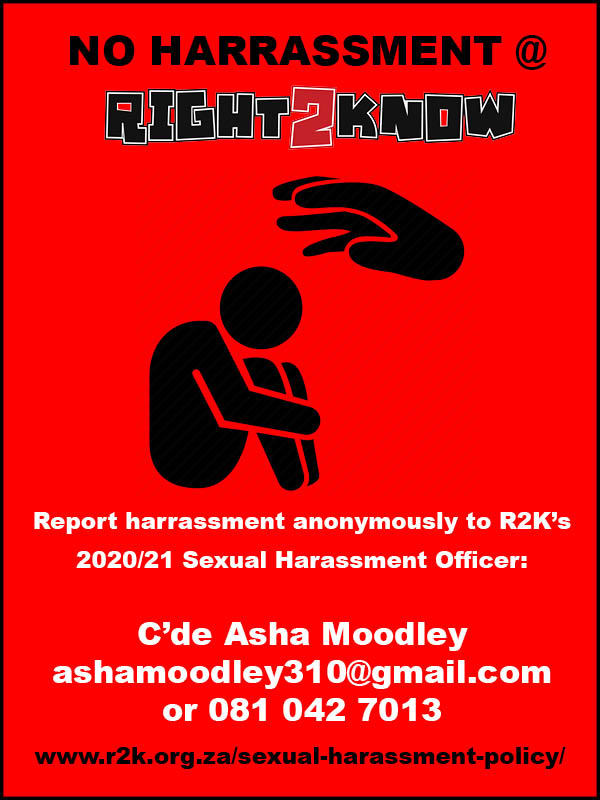 Our 2020/21 Sexual Harassment Officer is Asha Moodley. Please report any allegations of harassment to her: ashamoodley310@gmail.com or 081 042 7013.
Our 2020/21 Sexual Harassment Officer is Asha Moodley. Please report any allegations of harassment to her: ashamoodley310@gmail.com or 081 042 7013.
From the R2K Policy & Procedures Manual (as of May 2016). Also See Staff & Activists Code of Conduct & Disciplinary procedures
12.1 Preamble
Violence against women is endemic in most societies around the world. Sexual harassment is an expression of violence against women and is rife in most institutions such as the home, religious institutions, the workplace and organisations in civil society. It is indicative of the unequal power relations between men and women in a patriarchal system.
Sexual harassment within workplaces and in organisations is a substantial problem for both men and women although most victims are women. Studies have shown that 77% of working women have been victim to sexual harassment at some point in their lifetimes, that women who challenge men for social, economic, or organizational power are at a higher risk of sexual harassment. These statistics are astoundingly high, and warrant diligent action to prevent their further occurrence.
Many of these occurrences, as many as 3 out of 5, go unreported. There are several reaspons for this. Firstly, many people see sexist behaviour including sexual harassment as normal. Secondly, most people are unaware of their rights when it comes to sexual harassment. Thirdly, even if there is an awareness, people are afraid of the negative consequences resulting from reporting sexual harassment, for example not being considered for opportunities or loss or their jobs.
Sexual harassment victims confront intense consequences. Victims have shown symptoms of debilitating stress, weight loss or gain, anxiety, lowered self-esteem, sleep disorders, and depression, leaving them powerless and to take on their perpetrators. At the same time, if not dealt with, perpetrators remain in positions of power and authority, unscathed.
Sexual harassment serves to silence its victims. It has a severe impact on the right to freedom of expression and also hampers those affected in their socio-economic and political life.
R2K is committed to creating an activist environment which is safe for all activists, respectful of the inherent physical dignity and psychological integrity of everyone, and that recognises universal, fundamental human equality. We commit to creating an enabling environment for women and men free from sexual harassment. The problem of sexual harassment is widespread, and though R2K is an organization of justice activists we cannot assume that practices of sexual harassment will not occur in our midst.
Through this policy, we explicate the rights of every R2K supporter, and encourage that they are drawn upon in the event sexual harassment occurs. To sexually harass any other supporter of R2K is not anyone’s right; it is a violation of a person’s right to dignity and equality. It is unacceptable, and inexcusable. Through this policy, we work to eradicate any sexual harassment within this organization.
12.2. What is harassment
1.1 Harassment of anyone on the basis of gender, sex, or sexual orientation is a form of discrimination and is unlawful on the basis of our Constitution and legislation. It is also inconsistent with our R2K Activist Code of Conduct.
1.2 Harassment is often an expression of the very heteronormative patriarchal power relations in society that the R2K opposes and works to eradicate.
1.3 Harassment can be experienced by anyone as verbal, physical and psychological abuse. It is always unwelcome and unwanted, may be persistent and it demeans or humiliates or creates a hostile or intimidating environment.
- Sexual harassment may include unwelcome physical, verbal or non-verbal conduct.
- Physical conduct of a sexual nature includes all unwanted physical contact, ranging from touching to sexual assault and rape.
- Verbal forms of sexual harassment include unwelcome innuendoes, suggestions and hints, sexual advances, comments with sexual overtones, sex-related jokes or insults or unwelcome graphic comments about a person’s body made in their presence or directed toward them, unwelcome and inappropriate enquiries about a person’s sex life, and unwelcome whistling directed at a person or group of persons.
- Non-verbal forms of sexual harassment include unwelcome gestures, unwelcome sexually explicit electronic messages, indecent exposure, and the unwelcome display of sexually explicit pictures and objects.
- Quid pro quo harassment occurs where a person with more power, undertakes or attempts to influence the process of employment, promotion, training, discipline, dismissal, salary increment or other benefit of a person with less power, in exchange for sexual favours.
- Sexual favouritism exists where a person who is in a position of authority rewards only those who respond to his/her sexual advances, whilst other deserving parties who do not submit themselves to any sexual advances are denied opportunities.
All forms of sexual harassment should be viewed as serious violations of the victims rights to human dignity, equality and freedom.
- Consent is affirmative and repeated agreement between two parties.
- Consent in sexual relationships is important in determining whether conduct constitutes sexual harassment or not. Consent means that persons in a sexual encounter agree to it. More importantly, any party in such an encounter can withdraw consent at any time and stop the sexual activity.
- It is the responsibility of the initiator to obtain consent from the other person involved. Consent for any further intimate actions must be obtained in order for the act to be considered consensual.
- Consent to one type of sexual activity does not mean consent to any other type.
- Previous sexual interaction or relationship does not imply consent in the future.
- Silence does not imply consent.
- Consent is not implied in a person’s dress or appearance.
- Accepting a social invitation is not consent, and does not imply consent.
- Consent cannot be obtained if the other person’s capacity is diminished in any way by unconsciousness, alcohol, drugs or medicines.
- Consent is also required even though two people might be in an already negotiated intimate relationship.
12.3 Who Can Be Victims or Perpetrators of Sexual Harassment
3.1 Women, men, and members of the LGBTIQ community, can be the targets of or perpetrators of sexual harassment, which can take the form of a hostile environment or even of specific benefits in exchange for sexual favours. These can also be perpetrators.
1.4 Guidelines for Complainants of Sexual Assault
12.4.1 The Complaints Mechanism
- Each year the NWG will elect or appoint a R2K Sexual Harassment Officer at their first meeting. The name and contact details of the Sexual Harassment Officer will be communicated on all Provincial email lists.
- If requested the Sexual Harassment Task Team officer should undergo gender sensitivity training.
- The complainant can report her /his complaint, either verbally or in writing to the Sexual Harassment Officer any member of the NWG, Provincial Coordinator or Staff member who the victim trusts – even if s/he is not sure whether it constitutes sexual harassment.
- If the complainant reports to a member of the NWG, Provincial Coordinator, or Staff member this member must report the complaint to the Sexual Harassment Officer
- The victim’s identity can remain anonymous if requested.
12.4.2 Who can lay a complaint of sexual harassment:
- Any R2K supporter can lay a compliant regarding sexual harassment.
- If the complainant is not the alleged primary victim of the harassment the alleged primary victim should be offered all the provisions due to the complainant in this policy.
- If the complainant’s and the alleged primary victim’s preferred remedies are in contradiction the alleged primary victim’s preferred remedies should take precedence.
12.4.3 Establishing a Ad-hoc Sexual Harassment Task Team
- The Sexual Harassment Officer may either address the matter him/herself or establish an Ad-hoc Sexual Harassment Task Team.
- The Sexual Harassment Officer can establish an Ad-hoc Sexual Harassment Task Team proposing names of any R2K activist or calling for volunteers on the NWG list.
- The NWG can approve the names of the Task Team, but cannot prevent the establishment of the Team.
1.5 Guidelines for Sexual Harassment Officer or Ad-hoc Sexual Harassment Task Team
12.5.1 General Guidelines
- The Sexual Harassment Officer/Team should adhere to the principles of confidentiality, sensitivity, professionalism, impartiality, people’s right to equality, dignity, respect and inclusivity.
- The Sexual Harassment Officer/Team should address the complaint considering:
- the remedy desired by the victim;
- R2K’s Activist or Staff disciplinary procedure;
- the relationship between the parties;
- the impact on the complainant and the Campaign.
- The Sexual Harassment Officer or Task Team can consider recommending disciplinary action be taken against in the alleged perpetrator and/or referral to an organisation with an experience on such issues, identified for this purpose.
- Throughout the process care must be take to avoid the secondary victimisation of the complainant – this can include ensuring the complainant remains anonymous.
- The complainant of sexual harassment is not required to try and solve the problem with the alleged perpetrator as that may serve to reinforce the power relations in the interaction.
- The remedies outline in this policy in no way supercedes the complainant’s rights to take legal action.
12.5.2 Investigating the complaint
- When a complaint is made or an incident reported, the Officer/Team must gather sufficient information to either find a remedy or recommend disciplinary action.
- The Officer/Team may consider speaking to both the complainant, the alleged perpetrator, and/or possible witnesses separately in order to gather information (this can be done verbally or in writing).
- If appropriate the alleged perpetrator may be compelled to respond to the complaint and the Officer/Team must then share the response of alleged perpetrator with the complainant. If on that basis s/he wants mediation, then the task team can serve as mediator.
12.5.3 Taking disciplinary or other action
On the basis of the information gathered and the preference of the complainant the Officer/Team may consider one or more of the following remedies:
- Referral the complainant to an organisation with an experience on such issues, identified for this purpose;
- Offering to serve as a mediator between the parties,
- Communicating verbally or in writing with the alleged perpetrator that their behavior is unwelcome, unwanted, and is interfering with work or activism.
- Recommend the NWG institutes disciplinary hearngi as per the Activist or Staff Disciplinary Procedures.
- In these proceedings the Sexual Harassment Officer will lead evidence against the accused.
- The disciplinary process should process should be undertaken swiftly.
- Sexual Harassment is a major offence and the form of discipline can include a written warning, suspension from certain activities or expulsion from the campaign.
1.6 Maintaining records of Sexual Harassment
- All reported incidents of sexual harassment should be documented by the NWG and filed safly in the R2K National Office in order to monitor the prevalence of harassment within R2K
1.7 Ongoing activist training
- R2K should consider undertaking ongoing assertiveness training for women and vulnerable groups

